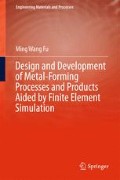Abstract
In the current metal-forming product design and development paradigm, product cost, time-to-market, and product quality are three overriding issues, which determine the competitiveness of the developed products. In up-front design process, the first 20 % of design activities commits to more than 75 % of product development cost and product quality issues. How to conduct “design right the first time” is critical to ensure low product development cost, high product quality, and short time-to-market. To address these issues, state-of-the-art technologies are needed to support design solution generation, evaluation, and optimization in metal-forming product design and development. Traditionally, computer-aided design (CAD) and computer-aided manufacturing (CAM) technologies provide approaches for representation and realization of design solutions physically [1]. However, how to generate design solution and conduct design solution evaluation and optimization is a non-trivial issue. In metal-forming product design and development, it is difficult to simultaneously address the design issues related to metal-formed part design, forming process determination, process parameter configuration, tooling structure design, material selection, prediction of the properties of deformed part, and finally the product quality control and assurance. In addition, how to reveal, assess, and evaluate the interaction and interplay of different design variables or factors in the above-mentioned different stages and areas is another critical issue. Computer-aided engineering (CAE) technology fills this gap as it helps practitioners generate, evaluate, and optimize design solutions before the best design solution is feasibly and uniquely identified and practically and physically implemented. In the current metal-forming product development paradigm, CAE simulation technology is one of the state-of-the-art technologies, which has been widely used in addressing the above-mentioned technical issues and will be used to solve the emerging bottleneck problems in the next upward trend of technology and product development.
Access this chapter
Tax calculation will be finalised at checkout
Purchases are for personal use only
References
Fuh JYH, Zhang YF, Nee AYC, Fu MW (2004) Computer-aided injection mould design and manufacture. Marcel Dekker Inc, New York
Kobayashi S, Oh SI, Altan T (1989) Metal forming and the finite-element method. Oxford University Press, Oxford
Bariani PF, Negro TD, Bruschi S (2004) Testing and modeling of material response to deformation in bulk metal forming. Ann CIRP 53(2)
Fu MW, Yong MS, Tong KK, Muramatsu T (2006) A methodology for evaluation of metal forming system design and performance via CAE simulation. Int J Prod Res 44:1075–1092
Tong KK, Yong MS, Fu MW, Muramatsu T, Goh CS, Zhang SX (2005) A CAE enabled methodology for die fatigue life analysis and improvement. Int J Prod Res 43:131–146
Fu MW, Yong MS, Muramatsu T (2008) Die fatigue life design and assessment via CAE simulation. Int J Adv Manuf Technol 35:843–851
Fu MW, Yong MS, Tong KK, Danno A (2008) Design solution evaluation for metal forming product development. Int J Adv Manuf Technol 38(3–4):249–257
Lange K, Cser L, Geiger M, Kals JAG (1992) Tool life and tool quality in bulk metal forming. Ann CIRP 41(2):667–675
Jirathearanat S, Hartl C, Altan T (2004) Hydroforming of Y-shapes—product and process design using FEA simulation and experiments. J Mat Proc Tech 146(1):124–129
Geiger M, Merklein M, Kerausch M (2004) Finite element simulation of deep drawing of tailored heat treated blanks. CIRP Ann 53(2):223–226
Petty DM (1996) Application of process modeling—an industrial view. J Mat Proc Tech 60:421–426
Bariani PF, Bruschi S, Dal NT (2004) Integrating physical and numerical simulation techniques to design the hot forging process of stainless steel turbine blades. Int J Mach Tools Manuf 44(9):945–951
Falk B, Engel U, Geiger M (1998) Estimation of tool life in bulk metal forming based on different failure concepts. J Mat Proc Tech 80–81:602–607
Mungi MP, Rasane SD, Dixit PM (2003) Residual stresses in cold axisymmetric forging. J Mat Proc Tech 142:256–266
MacCormack C, Monagham J (2001) Failure analysis of cold forging dies using FEA. J Mat Proc Tech 117:209–215
Fu MW, Luo ZJ (1992) The prediction of macro-defects during the isothermal forging process by the rigid-viscoplastic finite-element method. J Mat Proc Tech 32:99–608
Fu MW, Luo ZJ (1995) The simulation of the visco-plastic forming process by the finite-element method. J Mat Proc Tech 55:442–447
Scientific forming Technologies Corporation (2014) DEFORMTM 3D manual, Version 8.11
Cho H, Ngaile G, Altan T (2003) Simultaneous determination of flow stress and interface friction by finite element based inverse analysis technique. Ann CIRP 52:221–224
Mamalis AG, Johnson W (1987) Defects in the processing of metals and composites. In: Predeleanu M (ed) Computational methods for predicting material processing defects. Elsevier, Amsterdam
Gelin JC, Oudin J, Ravalard Y (1985) An improved finite element method for the analysis of damage and ductile fracture in cold forming processes. Ann CIRP 34:209–212
Reddy NV, Dixit PM, Lal GK (1996) Central bursting and optimal die profile for axisymmetric extrusion. ASME J Manuf Sci Eng 118:579–584
Clift SE, Hartley P, Sturgess CEN, Rowe GW (1990) Fracture prediction in plastic deformation processes. Int J Mech Sci 32:1–17
Reddy NV, Dixit PM, Lal GK (2000) Ductile fracture criteria and its prediction in axisymmetric drawing. Int J Mach Tools Manuf 40:95–111
Gouveia BPPA, Rodrigues JMC, Martins PAF (1996) Fracture predicting in bulk metal forming. Int J Mech Sci 38:361–372
Gupta S, Reddy NV, Dixit PM (2003) Ductile fracture prediction in axisymmetric upsetting using continuum damage mechanics. J Mater Process Technol 141:256–265
Ran JQ, Fu MW (2014) A hybrid model for analysis of ductile fracture in micro-scaled plastic deformation of multiphase alloys. Int J Plast 61:1–16
Li H, Fu MW, Lu J, Yang H (2011) Ductile fracture: experiments and computations. Int J Plast 27:147–180
Author information
Authors and Affiliations
Corresponding author
Rights and permissions
Copyright information
© 2017 Springer International Publishing AG
About this chapter
Cite this chapter
Fu, M.W. (2017). Evaluation of Forming System Design. In: Design and Development of Metal-Forming Processes and Products Aided by Finite Element Simulation. Engineering Materials and Processes. Springer, Cham. https://doi.org/10.1007/978-3-319-46464-0_3
Download citation
DOI: https://doi.org/10.1007/978-3-319-46464-0_3
Published:
Publisher Name: Springer, Cham
Print ISBN: 978-3-319-46462-6
Online ISBN: 978-3-319-46464-0
eBook Packages: Chemistry and Materials ScienceChemistry and Material Science (R0)

